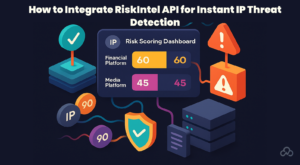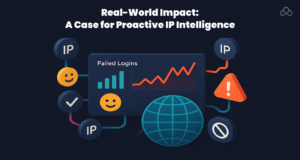In a digital world that works on connectivity and security and also where threats are constantly evolving. The increased cases of cyberattacks, especially those initiated through malicious IP addresses, has made it difficult for businesses to monitor every connection in real time. From phishing to brute-force attacks and botnets, harmful IP addresses can slowly infiltrate your systems without any warning until it’s too late. This is where the RiskIntel API comes in as a powerful strategy. By using this threat intelligence API into your existing security platform, you can easily detect and respond to unknown IPs to prevent damage before it happens.
Every modern organization, whether it’s a SaaS, fintech company, or e-commerce business, works with a constant flow of IP traffic. These IPs come from users, partners, bots, and sometimes, attackers. A traditional firewall or antivirus tool is not enough to handle your digital environment. What your business truly needs is intelligent, real-time protection that monitors each incoming IP to assign a risk score, and helps your system to decide how to handle it.
Why IP Threat Detection Matters in Today’s Cybersecurity Platform
Cyberattacks often start with simple tests with scans from IP addresses to test system vulnerabilities. These malicious IPs may be linked to spam networks known for phishing operations, or previously recorded attacks. If these connections are not spotted, they can lead to data leaks, system compromises, or financial fraud. IP threat detection is the foundational step of defense that spot these risks before they can happen. It allows your security platform to assess threats instantly and take action by denying access or by adding extra security checks.
At the IP level real-time threat detection is very important for applications with public APIs, user authentication systems, or large-scale traffic. Without intelligent screening, you could unknowingly give access to attackers disguised as ordinary users. Integrating a threat intelligence API like RiskIntel changes this equation by transforming your static security platform into dynamic, adaptive shields. It doesn’t just identify bad threats but also it helps to find them.
What Is RiskIntel API and How Does It Work?
RiskIntel API is a REST-based threat intelligence tool that monitors IP addresses in real time. Unlike traditional static blacklists, this cybersecurity API depends on AI-powered algorithms to understand behavior patterns like- geographic data, attack history, and global threat feeds to assign a contextual risk score to each IP. The response you get is great with actionable data, including whether the IP is associated with botnets, spam, malware, or other suspicious activity. It actually turns every IP request into a security platform.
The core of RiskIntel’s system is its machine learning engine, which learns from billions of data points to filter its risk assessments. When you query an IP address, the API gives a structured risk profile that your application can use to make intelligent decisions. If the risk score is high, you can block the IP or spot it for manual review. If the score is moderate, you might add a second level of authentication.
What You Need Before Getting Started
Before using RiskIntel into your platform there are a few measures that must be taken in place. First, you need to access your API infrastructure or backend systems where you can check incoming IP traffic. This could be your API gateway, web application firewall, or login system. You also need to sign up for a RiskIntel account and obtain your unique API key. This key authenticates your requests and allows your system to communicate securely with the RiskIntel servers. It’s important to keep this key private and secure to ideally stored in environment variables or a vault service.
Next, define the flow of IP traffic in your application architecture. Identify the points where IP analysis will be most useful. These could be during user login attempts like new account registrations, form submissions, or payment gateway access. By analyzing IPs at these critical stages, you can protect malicious behavior before it causes any harm. Planning your integration flow before checking that the implementation is fine and aligned with your existing cybersecurity strategies.
Step-by-Step Integration of RiskIntel API
The integration process starts with spotting an API call each time your system gets an IP address that needs to be monitored. This can happen in the background during logins, API calls, or any time a user sends data. Once the IP is captured, your backend sends it to RiskIntel’s endpoint using a secure HTTPS request along with your API key. The response is usually fast and includes key information such as threat category, blacklist status, geographic location, and an overall risk score.
Your system reads this data and applies conditional logic based on the risk score. For example, if the risk score is above a certain threshold is 75 out of 100 you can choose to block the request or send a CAPTCHA challenge. For mid scores, you might delay the processing or alert your security team. Low-risk IPs can proceed without interruption. This level of automation checks that your platform is making smart, risk-aware decisions without any human monitor every time. Thereafter, as the API continues to monitor more IPs it helps your system to learn and adapt which improves security outcomes continuously.
The Role of Risk Scoring in Strengthening Security

Risk scoring is at the heart of RiskIntel’s intelligence model. Rather than using binary logic (allow or block), the API gives a smart view of threats by assigning each IP a score based on various checklists. These involve behavioral history like known attack records, data center associations, abnormal traffic patterns, and the likelihood of future malicious activity. This scoring system is variable and evolves as new threat signals, checking your decisions are always based on up-to-date intelligence.
The ability to adjust your thresholds based on the context of your platform is another big advantage. A financial services platform may want to block any IP above a score of 60, while a media streaming platform may choose to compromise with a slight risk. This flexibility allows organizations to maintain a balance between security platform and user experience by adapting their policies based on specific business needs and risk tolerance.
Scaling IP Threat Detection Across Your Security Platform
Once you’ve successfully implemented RiskIntel at one point in your system, working it across your platform becomes easier. You can set up automated workflows to monitor IPs entering through different services including customer support tools, internal dashboards, and third-party integrations. Additionally, using RiskIntel with SIEM tools allows your security analysts to track threat data alongside other logs in real time which streamline incident response efforts.
For organisations handling huge volumes of IP traffic, batching API requests or integrating through middleware services can improve their performance. You can also create a caching layer that stores new threat scores to reduce repetitive requests for the same IPs. As you grow, you may find opportunities to enhance user profiles with IP trust levels or to customize content delivery based on risk insights. The possibilities to extend beyond just security platforms; they work on product performance and user experience as well.
Using AI Consulting Services for Advanced Threat Modeling
While RiskIntel gives a powerful amazing solution, the organizations with complex environments can use it with AI Consulting Services . These services can help you to build custom models that work with your specific industry threats, compliance requirements, and internal data sources. For example, a healthcare industry might need good protection against ransomware IPs, while a retail business might focus more on fraud prevention.
AI consultants can also help in building dashboards to automating incident responses, and setting up anomaly detection mechanisms that work beyond the standard API features. When you connect RiskIntel’s real-time intelligence with a bespoke AI-driven security platform, you get an extra defense system that changes with your threat scenarios.
Real-World Impact: A Case for Proactive IP Intelligence

A digital payments platform that spot a sudden increase in failed login attempts during off-peak hours. Their internal logs flagged hundreds of unique IP addresses where none of them had previously triggered any alarms. After integrating RiskIntel, they discovered that many of these IPs were already flagged globally for threat behavior. Within the first week, the platform blocked over 2,500 malicious IPs and saw a 40% reduction in login-related downtime, and improved user trust amazingly. This level of proactive detection not only strengthened their security but also saved operational time and money.
Conclusion
The future of cybersecurity API depends on intelligent, adaptive platforms that can spot and respond to threats instantly. Integrating the RiskIntel API is a main step in that direction. It empowers your systems to think before they act, evaluating the trustworthiness of every IP and taking action. With real-time IP threat detection, the risk scoring, and machine learning capabilities, your security platform becomes proactive, not reactive.
If your organization is serious about protecting data breaches and reducing attack surfaces, and maintaining user trust, now is the time to invest in intelligent threat detection. RiskIntel makes this possible with less friction and maximum flexibility. Whether you’re just starting your cybersecurity journey or looking to grow an existing stack, this API gives a scalable and powerful solution that grows with your business.
Do you like to read more educational content? Read our blogs at Cloudastra Technologies or contact us for business enquiry at Cloudastra Contact Us